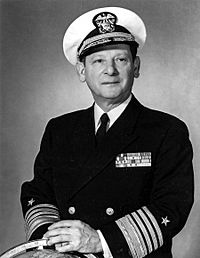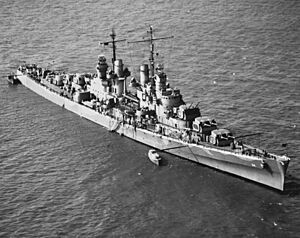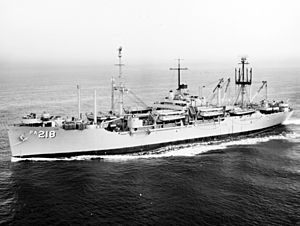Horacio Rivero Jr. facts for kids
Quick facts for kids
Horacio Rivero Jr.
|
|
|---|---|

Admiral Horacio Rivero Jr.
First Puerto Rican and Hispanic four-star Admiral and second Hispanic to become a Full Admiral in the United States Navy |
|
| Born | May 16, 1910 Ponce, Puerto Rico |
| Died | September 24, 2000 (aged 90) Coronado, California, US |
| Place of burial |
Fort Rosecrans National Cemetery
San Diego, California, US |
| Allegiance | United States |
| Service/ |
United States Navy |
| Years of service | 1931–1972 |
| Rank | Admiral |
| Commands held | USS William C. Lawe (DD-763) USS Noble (APA-218) Amphibious forces, Atlantic Fleet Commander of Allied Forces in Southern Europe |
| Battles/wars | World War II Korean War Cuban Missile Crisis Vietnam War |
| Awards | Navy Distinguished Service Medal Legion of Merit Bronze Star with "V" |
| Other work | U.S. Ambassador to Spain |
Horacio Rivero Jr. (born May 16, 1910 – died September 24, 2000) was a very important person in the United States Navy. He was the first Puerto Rican and Hispanic to become a four-star admiral. This is a very high rank! He was also the second Hispanic person to reach this rank in the modern U.S. Navy. Before him, only Admiral David Glasgow Farragut from the American Civil War had done so. After leaving the Navy, Rivero became the U.S. Ambassador to Spain from 1972 to 1974. He was the first Hispanic person to hold this job too.
Contents
Growing Up in Puerto Rico
Horacio Rivero Jr. was born and grew up in Ponce, a city on the southern coast of Puerto Rico. He went to school there for his early education.
Starting a Military Career
On June 20, 1927, Horacio Rivero Jr. received a special invitation. He was asked to attend the United States Naval Academy. This is a famous school for future Navy officers. He graduated from the Naval Academy in Annapolis, Maryland, on June 4, 1931. He was one of the top students, finishing third in a class of 441!
Rivero's first job was on a ship called the USS Northampton (CA-26). From 1932 to 1936, he served on several other ships. These included the USS Chicago (CA-29), USS New Mexico (BB-40), USS California (BB-44), and USS Pennsylvania (BB-38). In 1940, he earned a special degree in electrical engineering. He got this degree from the Massachusetts Institute of Technology (MIT). In 1941, he married Hazel Hooper.
Serving in World War II
During World War II, Horacio Rivero Jr. was a gunnery officer on the USS San Juan (CL-54). His job was to make sure the ship's guns helped protect Marines. These Marines were landing on islands like Guadalcanal, the Marshall Islands, Iwo Jima, and Okinawa. For his brave service, he received the Bronze Star. This medal came with a special "V" for valor (bravery).
Later, Rivero was moved to the USS Pittsburgh (CA-72). This ship had a big problem: its front part was torn off during a huge typhoon (a very strong storm). Rivero's smart plans saved the ship. No one on board was lost! Because of his actions, he earned the Legion of Merit. He also took part in many important battles. These included the Battle of the Santa Cruz Islands and attacks on Bougainville. He also helped capture the Gilbert Islands. On June 5, 1945, Rivero was part of the first air attacks by aircraft carriers against Tokyo, Japan.
After the war, from 1945 to 1946, Rivero worked on special weapons for the Navy. He also helped with important tests of atomic weapons in 1947 and 1948. These tests were called Operation Crossroads and Joint Task Force Seven.
The Korean War and Beyond
After World War II, Rivero became the commander of the USS William C. Lawe (DD-763). During the Korean War, he commanded the USS Noble (APA-218). Under his leadership, the Noble sailed to Korea. It helped with the Inchon amphibious (land and sea) attack in September. The Noble also helped move U.S. and other troops and equipment.
In July 1953, the Noble took part in Operation Big Switch. This operation moved Communist North Korean prisoners. It was part of the agreement to end the fighting.
Rivero then studied about nuclear weapons. In 1954, he became an Assistant Chief of Staff for Naval Operations. In 1955, he was promoted to rear admiral. He also worked with the Commander in Chief of the Western Atlantic Area. From 1958 to 1959, he commanded Destroyer Flotilla One in Japan.
The Cuban Missile Crisis
The Cuban Missile Crisis was a very tense time in 1962. The Soviet Union had placed nuclear missiles in Cuba. This was very close to the United States. On October 22, 1962, President John F. Kennedy sent Admiral Rivero to lead the American fleet. Their mission was to create a "quarantine" (a blockade) around Cuba. This was to stop Soviet ships from bringing more missiles. The goal was to prevent the Cold War from turning into World War III.
On October 28, the Soviet leader, Nikita Khrushchev, agreed to remove the missiles. President Kennedy then ended the blockade on November 20. This brought the crisis to an end.
After this, on July 31, 1964, Rivero became the first Puerto Rican to be a four-star admiral. He was also the second Hispanic person to reach this rank in the modern U.S. Navy. He was named Vice Chief of Naval Operations.
Role in the Vietnam War
During the Vietnam War, Admiral Rivero was the Vice Chief of Naval Operations. This meant he oversaw the Navy's daily operations. He strongly supported using a "brown-water navy." This was a special force of small boats that operated on the rivers of South Vietnam.
The USS Liberty Incident
In 1967, while he was Vice Chief of Naval Operations, Admiral Rivero spoke up for the sailors of the USS Liberty. This ship was attacked by mistake. Rivero later said his strongest memory of the Liberty was his "anger and frustration" that the attackers were not punished.
Leading NATO Forces
From 1968 until he retired in 1972, Admiral Rivero was a top commander for the North Atlantic Treaty Organization (NATO). He was the Commander in Chief of the Allied Forces in Southern Europe. His job was to lead the land, sea, and air forces from five countries. These countries were Italy, Greece, Turkey, Britain, and the United States. These forces were located in the Mediterranean area.
From 1972 to 1975, Admiral Rivero served as the U.S. Ambassador to Spain. He held this position under President Richard M. Nixon. Rivero was also an important leader for a group called the American Veterans' Committee for Puerto Rico Self-Determination.
Admiral Horacio Rivero Jr. passed away on September 24, 2000. He was buried with full military honors at the Fort Rosecrans National Cemetery in San Diego, California. He left behind a daughter, two grandchildren, two great-grandchildren, and two sisters. On November 11, 2008, the government of Puerto Rico honored him. They showed an oil painting of Admiral Horacio Rivero Jr. in the Capitol Rotunda.
Awards and Recognitions
Admiral Rivero received many awards and medals for his service. Here are some of them:
| Navy Distinguished Service Medal with two gold award stars | ||
| Legion of Merit with gold star | Bronze Star with "V" Device | Navy and Marine Corps Commendation Medal |
| American Defense Service Medal with one service star | American Campaign Medal | Asiatic-Pacific Campaign Medal with two service stars |
| World War II Victory Medal | National Defense Service Medal with one service star | Korean Service Medal with two service stars |
| Vietnam Service Medal with two service stars | United Nations Korea Medal | Vietnam Campaign Medal |
On April 1, 2017, a building at Fort Buchanan, Puerto Rico was named after Admiral Horacio Rivero Jr. This building belongs to the United States Navy Reserve.
See also
 In Spanish: Horacio Rivero Jr. para niños
In Spanish: Horacio Rivero Jr. para niños
- Hispanic Admirals in the United States Navy
- List of Puerto Ricans
- Puerto Ricans in World War II
- List of Puerto Rican military personnel
- Hispanics in the United States Navy
- Hispanics in the United States Naval Academy



